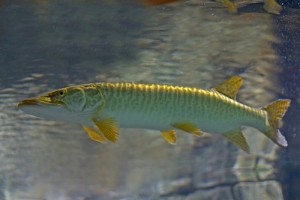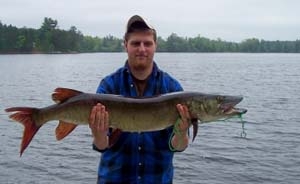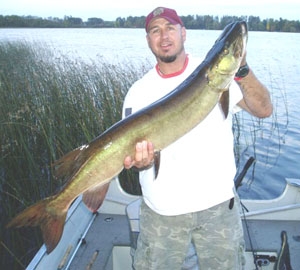
Breakfast, Lunch and Dinner
Muskellunges have
a "lone wolf" type of feeding. They typically lie in the weeds,
literally, and wait for prey to go by. A
fry (Muskellunge juvenile) will usually begin
predation of other fish only 4 days after birth, until then they usually eat smaller
organisms like water spiders. Muskellunges can begin aggressive
predation at only 2 inches of length. Due to flexible jaws,
Muskellunges can eat an organism up to 30% of its body size. Adults
eat a wide variety of organisms like
Largemouth Bass, ducks (Anas
platyrhynchos or
Aix spansa). However,
with regards to the season, Muskellunges are actually very finicky
eaters. They usually eat only smaller fish in the spring, and raise
the stakes in the fall going after much bigger prey. Most commonly,
Muskellunges won't eat a lot when the temperatures are below 50
degrees Fahrenheit in the spring. When temperatures are between
70 and 80 degrees, Muskellunge feeding is in full force. This
elevated level of feeding continues into the fall, however once the
temperatures fall below 40 degrees the rate of consumption greatly
deceases. Muskellunges usually remain quite dormant during the
winter months. To see some Muskellunges in action, watch
http://www.youtube.com/watch?v=6BHgp41NE4k&feature=related,
you will no longer wonder why they have the word "lunge" in their
name (The whole video is good, but the best action is about 1:05
into the footage). This video shows the quick strike of a hungry
Muskellunge.
commonly,
Muskellunges won't eat a lot when the temperatures are below 50
degrees Fahrenheit in the spring. When temperatures are between
70 and 80 degrees, Muskellunge feeding is in full force. This
elevated level of feeding continues into the fall, however once the
temperatures fall below 40 degrees the rate of consumption greatly
deceases. Muskellunges usually remain quite dormant during the
winter months. To see some Muskellunges in action, watch
http://www.youtube.com/watch?v=6BHgp41NE4k&feature=related,
you will no longer wonder why they have the word "lunge" in their
name (The whole video is good, but the best action is about 1:05
into the footage). This video shows the quick strike of a hungry
Muskellunge.
But searching the gut of a Muskellunge is like rolling a dice, you
probably won't know exactly you will find. Their prey can range
anywhere from water spiders to
dogs. They usually eat large minnows
and other game fish; but, they have been known to eat birds,
mice,
ducklings and frogs. Due to their large feeding pool, some people
think Muskellunges dominate lakes and kill all the other small fish.
However this is not true.
 Muskellunges
have such a large array of prey, that they never decimate any one
type of organism's population. In fact, this is the opposite of
Muskellunges. They are selective predators, meaning they allow
certain prey to go by. Although they consume a wide range of food,
they are not random feeders; some Muskellunges have exhibited prey
memory, meaning they will go after their favorite prey if it is
available. However, when the food source dwindles Muskellunges will
hunt outside of the box. They have been known to eat other
Muskellunges (although encounters are rare). When a Muskellunge goes
for prey, they usually attack the head region first. They try to get
as big of a bite on the head, in attempts to kill their prey immediately.
To watch the results of a Muskellunge bite on a Crappie,
http://www.youtube.com/watch?v=a5jCg2KnmXQ&feature=related,
skip to about 1:20 into the video (notice must of the 'destruction'
is
Muskellunges
have such a large array of prey, that they never decimate any one
type of organism's population. In fact, this is the opposite of
Muskellunges. They are selective predators, meaning they allow
certain prey to go by. Although they consume a wide range of food,
they are not random feeders; some Muskellunges have exhibited prey
memory, meaning they will go after their favorite prey if it is
available. However, when the food source dwindles Muskellunges will
hunt outside of the box. They have been known to eat other
Muskellunges (although encounters are rare). When a Muskellunge goes
for prey, they usually attack the head region first. They try to get
as big of a bite on the head, in attempts to kill their prey immediately.
To watch the results of a Muskellunge bite on a Crappie,
http://www.youtube.com/watch?v=a5jCg2KnmXQ&feature=related,
skip to about 1:20 into the video (notice must of the 'destruction'
is directly below the head).
To see another great video of a Muskellunge in action, go to
http://www.youtube.com/watch?v=0VQvFEytXIY
(I recommend you skip to about 40 seconds into the
video). Why do I only see the greatest number of
Muskellunge Fry during the spring?
directly below the head).
To see another great video of a Muskellunge in action, go to
http://www.youtube.com/watch?v=0VQvFEytXIY
(I recommend you skip to about 40 seconds into the
video). Why do I only see the greatest number of
Muskellunge Fry during the spring?